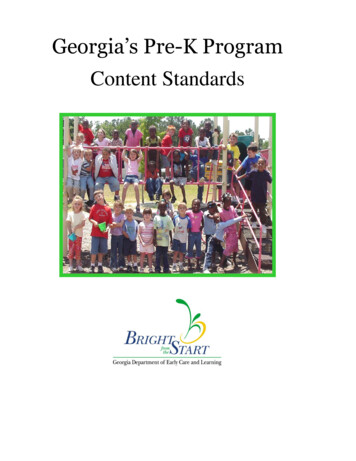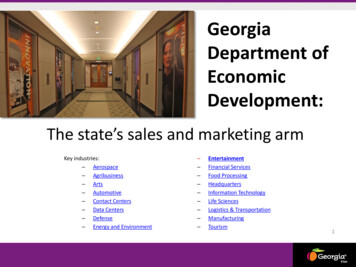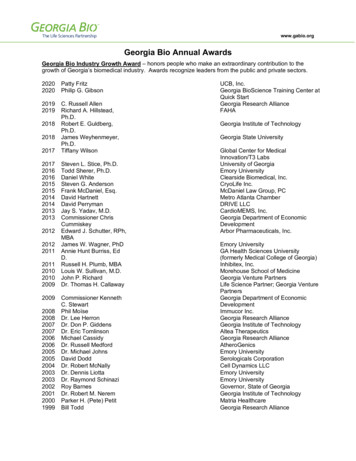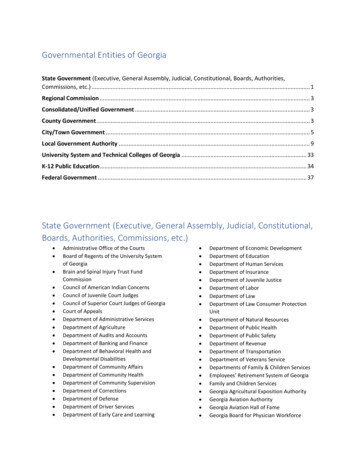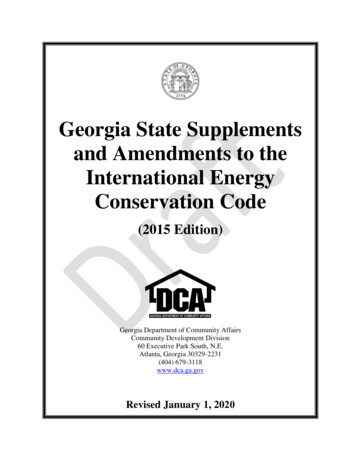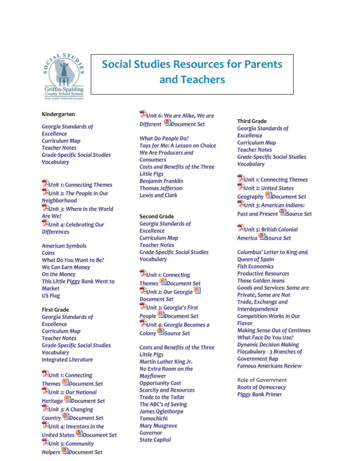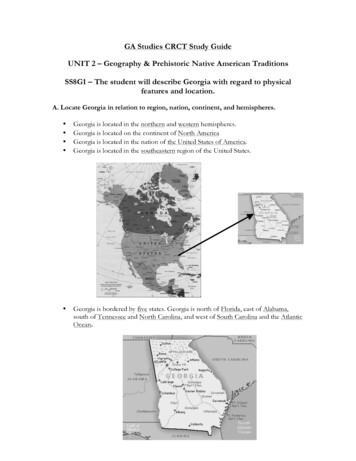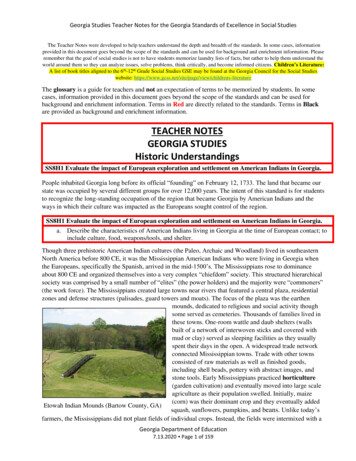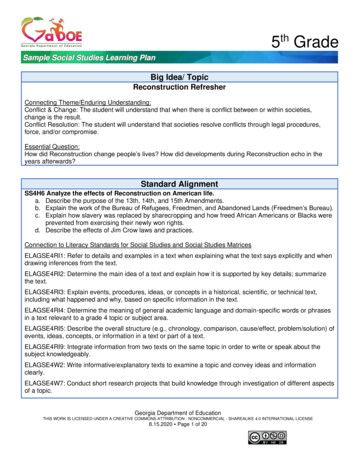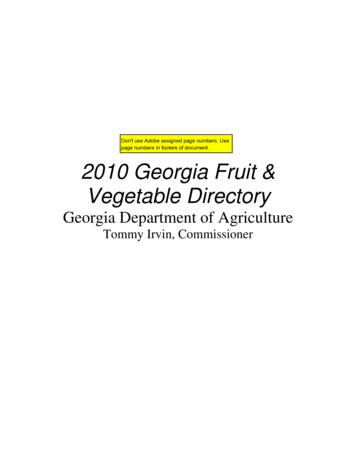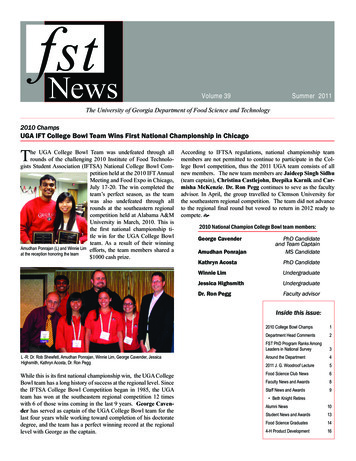
Transcription
fNewsstVolume 39Summer 2011The University of Georgia Department of Food Science and Technology2010 ChampsUGA IFT College Bowl Team Wins First National Championship in ChicagoThe UGA College Bowl Team was undefeated through allrounds of the challenging 2010 Institute of Food Technologists Student Association (IFTSA) National College Bowl Competition held at the 2010 IFT AnnualMeeting and Food Expo in Chicago,July 17-20. The win completed theteam’s perfect season, as the teamwas also undefeated through allrounds at the southeastern regionalcompetition held at Alabama A&MUniversity in March, 2010. This isthe first national championship title win for the UGA College Bowlteam. As a result of their winningAmudhan Ponrajan (L) and Winnie Lim efforts, the team members shared aat the reception honoring the team 1000 cash prize.According to IFTSA regulations, national championship teammembers are not permitted to continue to participate in the College Bowl competition, thus the 2011 UGA team consists of allnew members. The new team members are Jaideep Singh Sidhu(team captain), Christina Castlejohn, Deepika Karnik and Carmisha McKenzie. Dr. Ron Pegg continues to seve as the facultyadvisor. In April, the group travelled to Clemson University forthe southeastern regional competition. The team did not advanceto the regional final round but vowed to return in 2012 ready tocompete. 2010 National Champion College Bowl team members:George CavenderAmudhan PonrajanPhD Candidateand Team CaptainMS CandidateKathryn AcostaPhD CandidateWinnie LimUndergraduateJessica HighsmithUndergraduateDr. Ron PeggFaculty advisorInside this issue:2010 College Bowl Champs 1Department Head Comments 2FST PhD Program Ranks AmongLeaders in National Survey 3L -R: Dr. Rob Shewfetl, Amudhan Ponrajan, Winnie Lim, George Cavender, JessicaHighsmith, Kathryn Acosta, Dr. Ron PeggAround the Department 42011 J. G. Woodroof Lecture 5While this is its first national championship win, the UGA CollegeBowl team has a long history of success at the regional level. Sincethe IFTSA College Bowl Competition began in 1985, the UGAteam has won at the southeastern regional competition 12 timeswith 6 of those wins coming in the last 9 years. George Cavender has served as captain of the UGA College Bowl team for thelast four years while working toward completion of his doctoratedegree, and the team has a perfect winning record at the regionallevel with George as the captain.Food Science Club News 6Faculty News and Awards 8Staff News and Awards 9 Beth Knight RetiresAlumni News 10Student News and Awards 13Food Science Graduates 144-H Product Development 16
fst NewsDepartment Head CommentsGreetings from the Department ofFood Science and Technology! AsI reflect back we had a tremendous year.We again had a great year of achievements and hope to continue our excellence. The National Research Council(NRC) which ranks PhD programs in theUnited States ranked our program amongthe top in the nation, that made us the topprogram on the UGA campus. Kudos toour faculty and graduate students!Our IFTSA college bowl team won the national championship last summer, whichwas the first time in the history of thedepartment. Ourproduct development teams haveconsistently wonawards from different sponsors,such as PDMAand Danisco. Besides, the awardwinning students,Rakesh Singhwe have excellentfaculty members who have consistentlywon awards from various professionalsocieties. Recently two faculty members(Drs. Pegg and Huang) from our department were recognized on campus for bestteaching, which is a great honor for thedepartment.The three year (FY10 - FY12) budget cutsamount to more than 25% which is drasticconsidering that we already had 27% cutsduring 2003-2005 budget years. We havebeen constantly losing faculty and staffpositions and assistantship dollars. Thebright side is that we are still increasingour undergraduate enrollment, bringingextramural funds and providing qualityeducation. We have not overcome the lossof faculty and staff in the past few years,especially last year. We lost two facultymembers last December, but we are inthe process of filling those two positions.These two positions include a Food Engineering teaching and research position,and a Food Processing/Safety ExtensionSpecialist with extension and research assignments. Both these positions are critical to maintaining, as well as, enhancingthe quality of our programs.I want to take this opportunity to thankour donors and alumni for their solid support to the department. Currently, we aresoliciting funds to continue to fund the4-H Food Product Development competition which promotes food science concepts and creativity in high school students. The competition has encouragedseveral students to pursue college and afew have joined food science. I also request the graduating and current studentsto be actively involved in our program.As you start your future careers, remember your roots. Please stay engaged in theprogram by visiting us, giving seminars,becoming mentors to students and enriching our endowments. Thank you.Sincerely,Rakesh SinghProfessor and Department HeadVolume 39 Summer 2011fst News is published annually foralumni, friends and supporters of theUniveristy of Georgia Department ofFood Science and Technology.Editorial staff includes:Karen SimmonsProgram SpecialistMark HarrisonProfessorRuth Ann MorrowResearch ProfessionalBeth KnightAdministrative SpecialistSuggestions? Questions?foodsci@uga.eduVisit us on the web:Department of Food Scienceand Technology:http://www.foodscience.caes.uga.eduFood Science Extensionhttp://www.efsonline.uga.eduCenter for Food Safetyhttp://www.ugacfs.orgFood Product Innovation &Commercialization Center (FoodPIC)http://www.caes.uga.edu/center/foodpicUGA Food Science Clubhttp://www.uga.edu/dawgfoodPage 2fst News
FST PhD Program Ranks Among Leaders in National SurveyThe National Research Council(NRC) recently released its reporton the quality of PhD programs in theUnited States (http://www.nap.edu/rdp/#download). The report identifiedsix programs at UGA that are among thebest in the country, and our program wasone of them! Not only did we rate greatwhen comparing programs on campus,but when compared to other FoodScience doctoral programs in the U.S., wewere one of the best.The NRC conducts the survey approximately every 10 years, and Food Scienceprograms were included in the most recent survey. Data was collected from institutions, faculty, and doctoral studentsthrough questionnaires and surveys forthe 2005-2006 academic year from morethan 5,000 programs in 62 different academic fields from over 200 universities.The survey addressed research activities,student support and outcomes, and diversity of the academic environment.The NRC survey was not designed torank programs in a numerical order. Instead there were 20 attributes consideredthat included faculty activities (numberof publications and citations, number ofawards), student characteristics (GREscores, percent with fellowships), andbroader features of the doctoral programs(average time to complete a degree, measures of ethnic and gender diversity, etc.).The values of the 20 program variableswere derived from a data-gathering project the NRC conducted using multi pagequestionnaires that were filled out athundreds of institutions.Summer 2011The NRC used two procedures to determine the appropriate weights for thevariables. One method involved askingfaculty evaluators to identify features andattributes of doctoral programs that contribute to the program’s success. Evaluators selected the four most importantvariables and then named the two mostimportant. Since the faculty evaluatorsstated the preferences in the survey, dataanalyzed from this was called surveybased. This method indicates the preferences of experts in the field. The other setof weights asked faculty members to ratedoctoral programs and then looked at whatvariables correlated strongly to high andlow scores. Data analyzed from these evaluations was called regression-based andrepresent actual judgments of the experts.While the NRC did not design the finalreport to numerically rank programs,PhDs.org, an independent organization,has taken the NRC data and developeda search tool that allows one to compareprograms based on the variables of importance to them. The comparison tool isavailable at http://graduate-school.phds.org/.Highlights from the survey: Using the survey-based values, thetop Food Science programs in alphabetical order were Cornell, Purdue,Rutgers, UGA, the University ofMassachusetts, and the University ofWisconsin. Using the regression-based values,the top Food Science programs in alphabetical order were Cornell, OhioState, Purdue, UGA, and the University of Massachusetts. For faculty related variables, weplaced high in the number of publications per faculty member, averagenumber of citations per publication,and faculty awards. We rated high in several areas relatedto students. Examples are listed below. We were in the top 10 for thepercentage of full- and part-timestudents who complete their degreewithin 6 years. We were in the top 5 programsfor the percentage of non-Asianminorities in the program. We were the third rated programfor the number of students completing their PhD between 2002-2006with an average of 9.2/year. By comparison, the average for all the programs in the survey was 4.46/year. We had the third largest PhDFood Science program in 2005, withthe largest first year class.The quality of our program is a reflectionof the quality of the students who havebeen in the program. Our program hastraditionally been much more reliant ongraduate students to produce quality research rather than postdocs. So much ofthe data used for our part of the surveywas based on graduate student efforts andtruly reflects the quality of our alumni. Page 3
Around the DepartmentOur undergraduate program continues to thrive with enrollment hovering around the 65 mark. With this number ofstudents, it is not possible for Dr. Rob Shewfelt, the Undergraduate Coordinator, to advise the bulk of the undergrad studentsas he has done for many years. Thus advising duties have beendivided in recent years among other faculty members. In addition to Dr. Shewfelt and Dr. Mark Harrison, who continues toadvise the honors students, Dr. William Kerr, Dr. Ron Peggand Dr. Joe Frank now share in advising undergraduates.cal and cultural significance of wine production, botany andgeneral culture of grapevines, winemaking and enology, wineappreciation, and the health risks and benefits associated withwine consumption. Open to thirty students, the course is filled tocapacity every year.Every year in February, Dr. Shewfelt collaborates with theUGA Career Center to host a Careers in Food Science night.Advertised to the entire university community and held in theMiller Learning Center, the event consists of a panel of FoodScience alums that speak about their career paths and offer bitsof advice to students in the audience. The evening concludeswith a Q&A session. This year’s panelists included JordanShaw from Silliker Labs, Michael Paul from Valentine Industries, Shona Jonson from Chick-fil-A, Darlene Samuel fromUSDA, Josh Irvin from Richmond Baking and Ben Williamsfrom Coca-Cola NA.Students touring a winery in Cortona in 2010As the result of suggestions made during a departmentalreview, an advisory panel was formed to provide outsideinput with the goal of assisting the department in meeting itsgoals. The FST Industry Advisory Panel is composed of FoodScience graduates from across the spectrum of food occupations. Semi-annual meetings are scheduled in Athens. Membersof the advisory panel discuss a variety of topics with facultyand students. We value the experience the members bring andwelcome their feedback. A list of the members may be found ard.html.TPanelists at the Careers in Food Science eventNot to be outdone by the undergrads, our graduate studentenrollment has held steady with 68 students enrolled thissemester, including 11 MFT, 31 MS and 26 PhD candidates. Wehave nearly completed the admission process for fall 2011 andhave already received committments from 18 applicants thatplan to enroll. The FST Graduate Affairs Committee has had tomake some very difficult admission decisions as the number ofapplicants has increased for a limited number of slots availablein the program.This spring marks the fourth year of the study abroad course,Viticulture and Enology in the Mediterranean Region, to betaught at UGA’s Study Abroad site in Cortona, Italy. InstructorsDr. Joe Frank, Dr. Phil Brannen (Plant Pathology) and Dr. DaveLockwood (Horticulture) provide an introduction to the historiPage 4he department is currently in the midst of the search process for two new faculty members. Response has been goodto the position advertisements, and the search committees areworking to complete the process are quickly as possible. Openings for an assistant professor with expertise in food engineeringand another in the field of extension and food safety will hopefully be filled before the end of this summer.Every year, our department hosts diverse groups of visitorswishing to learn more about our programs, and the past yearhas been no exception. We have opened our doors to numerousgroups from local schools and organizations and have hostedfaculty visitors from around the world. Examples of those visiting the department include participants from the Georgia JuniorSciences and Humanities Symposium, the Governor’s HonorsProgram’s Tour of Technology, and the U.S. Department ofCommerce’s Special American Business Internship Training(SABIT) Beverage Processing and Packaging for Euarasia program. fst News
Buchanan Presents 2011 J. G. Woodroof LectureDr. Robert L. , Professor and Director, Center for Food Safety and Security Systems at the University of Maryland, presented the 2011 J. G. WoodroofLecture on March 24, at the GeorgiaCenter for Continuing Education on theUniversity of Georgia campus. This yearmarked the 30th anniversary of the annualWoodroof lecture, named in honor of Dr.Jasper Guy Woodroof, an internationallyrecognized leader in food science and thefounder of the food science program atthe University of Georgia. Dr. Woodroofpresented the inaugural lecture in 1981.Dr. Buchanan’s presentation, entitled“The Challenges of Moving from Hazard-based to Risk-based Food Safety Systems,” explored the evolving nature offood safety systems, including the broadscientific and policy concepts that impactour food safety systems and the processof moving from qualitative to quantitative systems. Scientific thinking dictatesthe need for an ability to mathematicallyevaluate the hazards associated with foodsystems in order to reduce the occurrenceof potential risks.According to Dr. Buchanan, the evolutionof food safety frameworks currently involves a move from hazard-based to risk-based controls and from reactive to preventive controls. The predominant foodsafety approach today employs the Hazard Analysis and Critical Control Points(HACCP) system, which as the nameimplies, is a hazardanalysissystem.The HACCP modelwhich originatedforty years ago wasalso the first attempt at a “systemsapproach” to foodsafety,meaningthe parts of a foodRobert L. Buchanansafety system wereviewed in the context of the whole ratherthan by examining components in isolation. While designed as a hazard-basedand primarily qualitative system, foodsafety experts are incorporating riskassessment components into HACCP tomove toward a more desirable quantitative approach. This move brings with ita unique set of challenges, Dr. Buchanannoted as the HACCP approach focuses oneliminating hazards and not on managingrisks and is often too complex to respondquickly when something goes wrong.Dr. Buchanan views the current foodsafety practices, both hazard-based andrisk-based, as points on a food safetycontinuum, and points will continue toadvance as food safety tools continue todevelop. He envisions a transition joining HACCP with quantitative systemsthat will broaden the systems approach tofood safety.In summary, the management of foodsafety risks has been undergoing a quietrevolution as it adopts risk analysis approaches. This is stimulating a dramaticshift from qualitative, often non-transparent decision criteria to quantitative, fullytransparent consideration of the scienceunderlying food safety decisions.In addition to his discussion of the changing landscape of food safety systems, Dr.Buchanan offered advice to the studentsin the audience. He expressed the needfor students to always be looking towardthe future and not to get stuck in the present. Otherwise they may find themselvesleft behind in an ever changing scientificworld filled with rapidly evolving technology. He challenged students to reinvent themselves professionally everyfew years as a way to prevent them fromgrowing too comfortable on their careerpaths. Food Science Club offers promotional itemsThe Food Science Club had promotionalitems made this year to increase awareness of food science at the Universityof Georgia. Items included coffee mugs,key chains and vinyl auto windowdecals. All the items are imprinted witha UGA logo and either the words “FoodScience & Technology” or”Food ScienceClub.”If interested in purchasing anypromotional items, please contact clubSummer 2011president Todd Fisk at fisktodd@uga.edu.Prices below do not include shipping.Coffee mug (black or cobalt blue) 10.00Key chain/bottle opener 1.00Vinyl auto decal 1.00Food Science & TechnologyThe University of GeorgiaPage 5
Food Science Club Adds New Activites to its Calendar of EventsJoseph Chen (L) and Jaideep Sidhu at the CAES Fall Kickoff CelebrationThis past year the Food Science Club had many new and improved activities presented to the department and its clubmembers. In the fall, our first event was the CAES Fall Kickoffat Four Towers. Here we promoted the club and socialized withother clubs from The College of Agricultural and Environmental Sciences. For our first community service activity of thefall, we teamed up with Rivers Alive and helped clean up theOconee River. The main social events of Fall 2010 were theHalloween Party and the Holiday Potluck Dinner. The club officers teamed up and organized a Halloween Party. At this event,we had food catered by Shane’s Rib Shack, had a food costumecontest and a tie dye shirt making corner. This event was verysuccessful and may become an annual club event. The annualHoliday Potluck and White Elephant Gift Exchangeheld in December was a time for faulty, staff andstudents to enjoy food and fellowship.This was greatto haveKellie Cookfair at the Halloween Partybecause it allowed all members of the department to interactand have fun. At the end of the semester as a special gift toour club members, the Food Science Club gave out final examsurvival packets during finals week. Each bag contained goodies and writing utensils to help prepare the members for theirfinals.In the spring, the highlight of the regularly scheduled clubmeetings were guest speakers from the Research Chefs Association (RCA) and from Newly Weds Foods. We started off thesemester with a guest speaker from the Research Chefs Association, Marshall Scarborough., who is an R&D Chef at Popeye’sChicken and Biscuits. He shared what he did on a daily basisand piqued the interest of club members about RCA. We alsohad a luncheon with Craig Lawson from Newly Weds Food.The club members gained more insight of the food scienceindustry from Craig. The Food Science Club created mugs,bumper stickers, and key chains to help promote our program (see page 5). These items have been a hit! We endedthe 2010-2011 year with the Spring Awards Ceremony. In addition to recognizing students scholarshiprecipients and awardees, the club announced theprofessors of the year as chosen by the Food Sc
Nov 11, 2010 · Science doctoral programs in the U.S., we were one of the best. The NRC conducts the survey approxi-mately every 10 years, and Food Science programs were included in the most re-cent survey. Data was collected from in-stitutions, faculty, and doctoral students through questionnai
